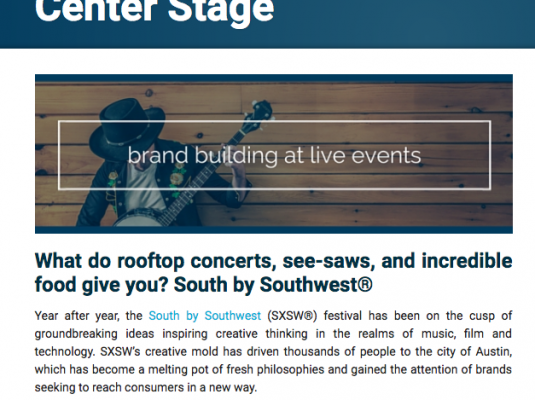
Distribion: Marketing & Music Branded Content Hits Center Stage with Justin Lefkovitch
What do rooftop concerts, see-saws, and incredible food give you? South by Southwest®
Year after year, the South by Southwest (SXSW®) festival has been on the cusp of groundbreaking ideas inspiring creative thinking in the realms of music, film and technology. SXSW’s creative mold has driven thousands of people to the city of Austin, which has become a melting pot of fresh philosophies and gained the attention of brands seeking to reach consumers in a new way.
Although some artists are reluctant to share the stage with branded content, the opportunity for brand activation at live music events like SXSW is too great to overlook. Momentum Worldwide recently surveyed over 6,500 people across the globe to compare the impact live events have on the whole brand experience. Not only do fans remember the event, they love to talk about it online and share with friends. The survey showed that after attending a live event, 68% of respondents searched for more information about the brand online and 93% of respondents talk to others about their live brand experiences. With so much chatter in a day of constant sharing, brands can achieve higher success when a strong social media engagement plan is in place surrounding live events.
The friendly relationship of social media and music
In the week during the festival, #SXSW soared in popularity on Twitter into the 77th percentile of all hashtags.1 One of the biggest contributors in the brand space came from @esurance, who offered fans who missed the festival the opportunity to catch up on keynote speakers and bands from the show on the esurance.com website. Twitter wasn’t the only social media outlet that saw a spike in traffic during the week-long event. The SXSW YouTube channel boasts almost 90,000 subscribers, and its Facebook page has an impressive 440,000 likes. From the viral videos to photos on Instagram, it’s become second nature for people to share an experience. And as a photo album was in the past, hashtags are the newest way for others (even strangers) to share the same experience in a new light.
Avoiding negative connotations
The global recorded music sales totaled $15 billion in 2013, and a large factor to the success of the music industry has come from the $4.5 billion annual investment in research and marketing.2 Justin Lefkovitch, CEO and founder of experiential music marketing firm Mirrored Media, describes the industry as “an exciting place that allows brands and artists to share a common message.” It is the message that Lefkovitch later expressed “needs to be about the artist and how we as marketers can help bring value to the fans.”
Mirrored Media has helped clients such as Coach and Acura find an authentic message that is organic to both the brand and the musicians. Without the right message, fans see right through the campaign and could have a negative image of not just the brand, but also the band. The fans are going to the show for the band, not the promoter or the brand sponsoring the event. Only after the consumer chooses to visit the brand’s website or other outlets can the brand tweak the message more toward supporting the product or service. Remember, the organic relationship with the band is the most important so that the fans are listening – and share when the time comes.
X-channeling @ sXsw
It was easy to see by the number of show flyers littered across the street that bands and brands alike were trying to capture the attention of SXSW show-goers. Sometimes called 360-degree marketing, cross-channel marketing is key to achieving a greater customer reach. A well-rounded campaign effort gives brands a greater likelihood of grabbing that attention and guide these music lovers to the brand.
Traditional posters and flyers have been the standard, but the integration of email and social media has become an integral part of promoting a brand in the music marketing space. Before, during, and after the event must be accounted for so that the brand hits as much of the customer buying cycle as possible. Again, nurturing is crucial so that the fan finds supporting materials if and when they are ready for more information.
While the artists are always going to have the most influence on fans, brands have been able to reach more consumers with the help of marketing automation. It is very common for brands to integrate the capabilities of scheduling posts to be sent out automatically at an event to share information and promotional items. What most people don’t know is that email blasts to subscriber lists, artist outreach websites, and social media posts can all be scheduled before the show even starts. While at an event, brands can still post to social network sites, but now the worry about getting the word out is gone – set it and forget it.
Planning allows brand representatives to be present, spend more time selling and engaging with show-goers, and have peace of mind that social brand message is already built and maintained. After all, it’s always going to be about customer interaction so that the brand can reach more potential purchasers.
– See more at: http://distributedmarketing.org/2015/03/27/marketing-music-branded-content-hits-center-stage/#sthash.YAkzf89H.dpuf
